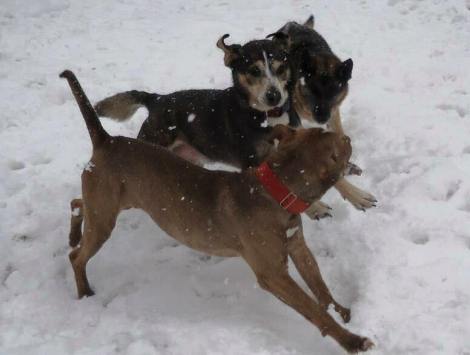Imperfect Dog Introductions:
Slow and Steady Keeps Everyone Happy and Safe
The following articles are a guideline to integrating dogs with a little emotional baggage. Most frequently, I use this to integrate foster dogs. I do some version of this introduction for every dog that is expected to live harmoniously at my house. For reactive/selective dogs that may not see each other again or would only be around for a day or so, I will typically just crate and rotate–it isn’t worth the effort of a true integration.
I realize that there are many dogs that can meet other dogs and be BFFs two seconds later.This guide is NOT for those dogs (although some of the principles could still be helpful). This is how I introduce and integrate dog-selective and dog-reactive dogs. My process for seriously dog-aggressive dogs is more intensive. That doesn’t mean that selective and reactive dogs can’t be aggressive. Indeed, they can and often will be in situations that are stressful for them.
Remember: Not every dog will get along with every other dog. And that is okay.
This is where I remind you that dogs are, in fact, animals. They are not robots. Just like people. Do YOU get along with everyone you meet? No. You don’t. I don’t. I guess we are all some degree of human-selective. Sometimes you instantly dislike a person. Sometimes you can tolerate a person but wouldn’t want to hang out with them. Sometimes you initially hate someone but realize over time that they are actually pretty awesome. Sometimes you are forced to babysit your friend’s kids and you can only take it for 2 hours.
Working through reactive/selective dog introductions is NOT for everyone and inherently puts your own animals at risk. Intensive management is key but people are fallible. I always try to make sure there are back up safe-guards so even if I mess up, both dogs should still be safe. Please read the site disclaimer. This is what works for me, but it may not be what works for you.
Never forget that dogs can seriously hurt or kill each other. No one likes to bring this up and everyone thinks ‘it can’t happen to me’ and they are wrong. I have had trusted, dog-experienced friends go through the horror of having their foster dog kill their resident dog. Because of their experience, I prepare for the absolute worst case scenario in dog-dog introductions. Dogs can be incredibly forgiving and most of the time I feel like a ninny for all of the precautions I am taking. Then something scary will happen–a dog will burst through a crate door, leap over a baby gate, or slip their collar–and I am boneless with relief that at a minimum, I prevented an unpleasant experience for both dogs.
Now that I have spoken about the potentially devastating and heavy reality, take a deep breath, remember how much you love dogs, shake it off, and review my process.
Below are the steps I usually take to introduce reactive/selective dogs, in the order I usually take them:
- Crate and Rotate
- Short, Positive Training Sessions
- Group Walks
- Interacting Through the Crate
- Interacting Through a Baby Gate/Exercise Pen
- Tie Downs, Leashes Indoors, and Drag Lines
- Yard Introductions
- Sharing the House
Here are some general rules for management of reactive/selective dogs during introductions:
- To be left home alone, they need a minimum of two solid barriers between them. I usually do three. At least one of the barriers needs to completely block vision. I typically recommend giving each dog their own room and kenneling them inside that room. For the dog I don’t know as well, I always kennel them. My own personal dog I may just keep in a separate bedroom.
- Make sure the kennel is secure. If you have a reactive dog, often times they are a little on the anxious side. If they aren’t kennel trained, they may really test the kennel and potentially escape it. I know of a dog that broke out of a kennel, chewed through a solid wood door and killed another dog that was loose in the house. A secure kennel is a MUST. I always zip-tie the crap out of mine just in case.
- For both dogs to be out, two people need to be in the home (typically in the room) and one person needs to be actively managing them.

